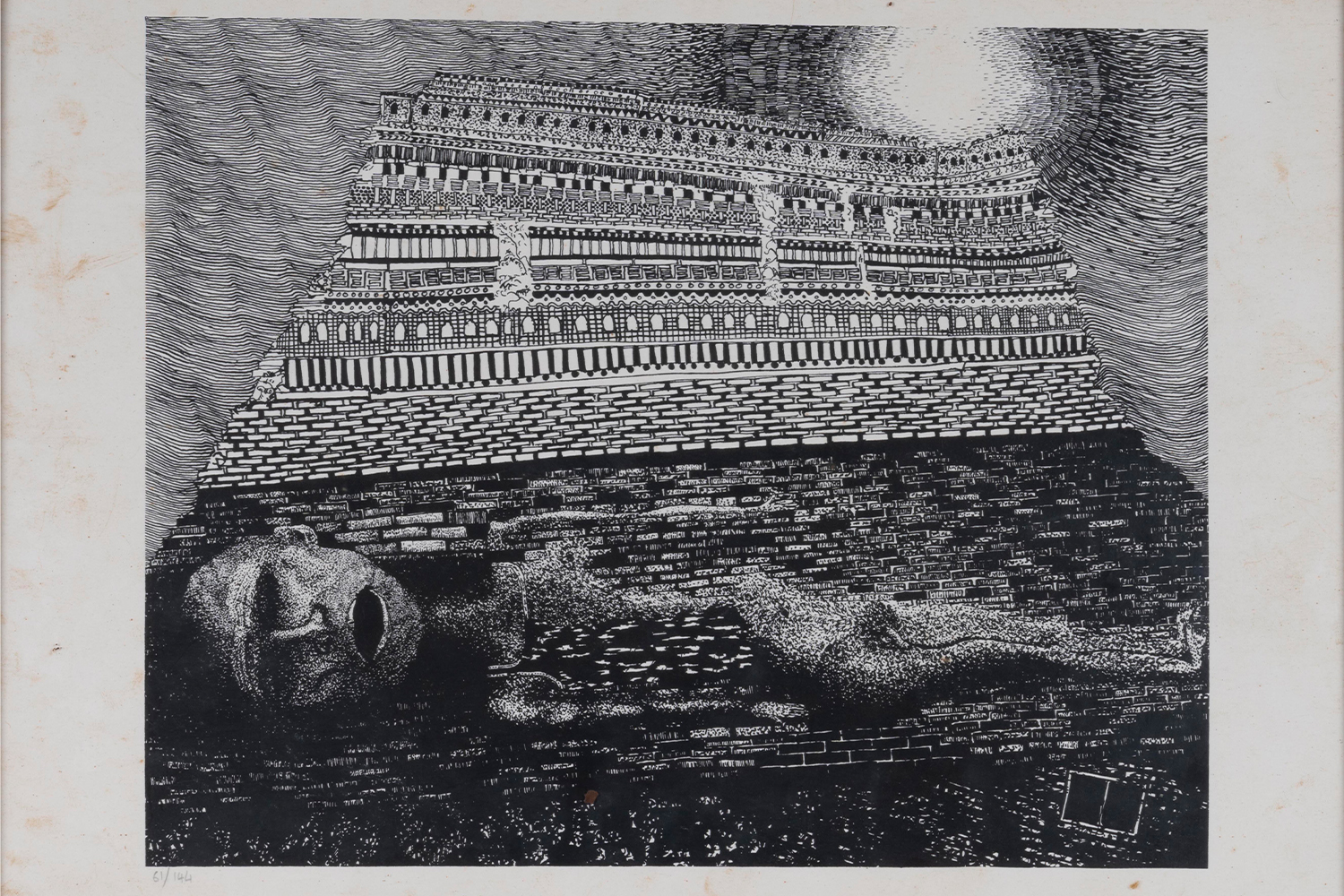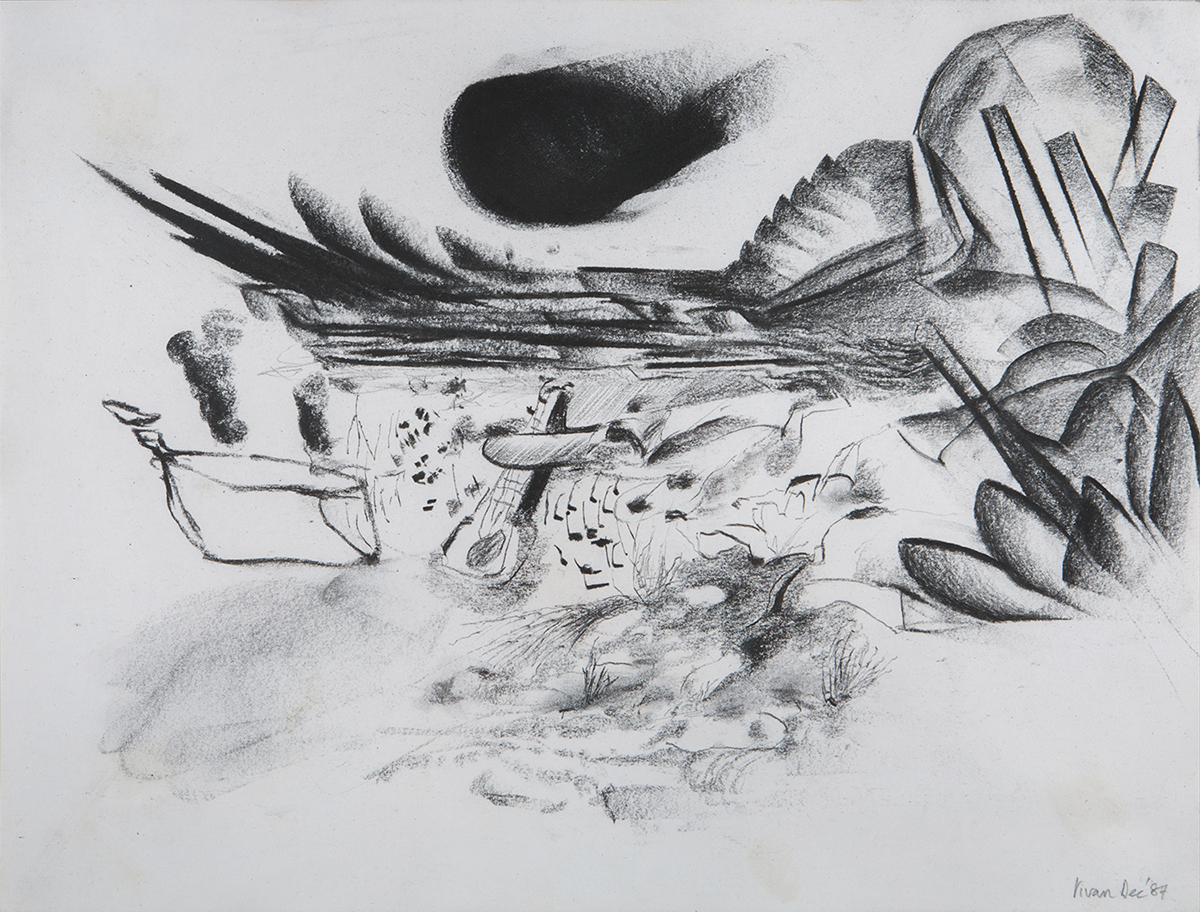ARTICLE
Vivan Sundaram
Sundaram’s early works were primarily in the narrative-figurative tradition, inherited from his alma, the MS University. Works such as Guddo (1980) and People Come and Go (1981), which typify this style, were featured in the group exhibition Place for People (1981) at Jehangir Gallery, Bombay (now Mumbai) and Rabindra Bhavan, New Delhi, accompanied by an essay by Geeta Kapur. The figures in Sundaram’s paintings were presented in their social contexts, a deliberate departure from the prevailing mode of abstraction that dominated modern art in the twentieth century.
Sundaram started working on installations from the early 1990s, incorporating sculpture, photographs, collage, found objects and video in his works. The installation Memorial (1993–2014) references the communal violence that took place in Mumbai in the aftermath of the Babri Masjid demolition in 1992. The thematic centre of the work is a black-and-white newsprint image of an unnamed victim by photojournalist Hoshi Jal, whose collaged and manipulated images are iterated sculpturally throughout the installation. At the centre of the room-sized installation navigated through metal barriers, sandstone tiles and a faux-gateway made of steel trunks, is a marble and glass “Mausoleum” for the victim. Another project that deals with history and memory through materiality is the site-specific installation Structures of Memory: Modern Bengal (1998), also known as the History Project. Held at the Victoria and Albert Museum, Kolkata, it sought to reflect upon fifty years of Indian independence.
With the works Great Indian Bazaar (1997) and living.it.out.in.delhi (2005) and Bed Ward (2005), which employed found objects and reused goods, Sundaram began to explore the themes of consumption and obsolescence and their material and social implications. These themes converged again in his work Trash (2005–2008), a multimedia assemblage of urban waste that takes the form of a cityscape. It reflects the collective scale, aesthetics and afterlife of urban detritus and other byproducts of consumerism. Works like Gagakawa (2011) and Postmortem (2013), in which used cloth and textile trash are repurposed into garments, also expand on the theme to reflect on the polluting practices of fashion and its consumption.
Another theme in Sundaram’s work is personal history, especially as it relates to melancholy and mortality. In his informal capacity as historiographer, he created The Sher-Gil Archive (1995), a meditation on the artist’s family history. The installation uses video work by Sundaram and photographs taken by Umrao Singh Sher-Gil, between 1864 and 1945, along with other personal items such as laces, wood boxes and letters. He revisits this family archive again in Re-take of Amrita (2001-02), in which he digitally choreographs photographs from the family album as a narrative that primarily revolves around the axis of the father-daughter relationship between Umrao and Amrita Sher-Gil. It includes extensive self-portraits by his grandfather, studio-style and careful portraits of his wife, Marie-Antoinette Baktay, and of his daughters. The work foreshadows the tragic death of Amrita and Marie-Antoinette’s subsequent suicide, following her daughter’s death, in the apparition-like figures and their composed solitude as well as Sundaram’s digital manipulations. The artist’s self-insertion into the collages indicates a temporal discontinuity that comes from reimagining and appropriating memories. The photomontage in this work is considered one of Sundaram’s seminal contributions to art and photography.
Sundaram has exhibited in several solo shows in India and abroad, as well as in events such as the biennials of Kochi, Havana, Johannesburg, Gwangju, Sharjah, Shanghai, and Berlin, as well as the Asia-Pacific Triennale, Brisbane. In 2018, the Kiran Nadar Museum of Art (KNMA), New Delhi, held a retrospective of his works spanning fifty years. In 2019, PHOTOINK held the exhibition Install: black gold, terraoptics and the work of termites (2019), which reflected on history and its retellings.
Sundaram’s contribution and influence extended beyond his oeuvre to the larger domain of artistic practice and collaboration. He established the Kasauli Art Centre (now the Kasauli Art Project), Himachal Pradesh, in 1976 to provide a space and resources for workshops, artist residencies and seminars. He was also one of the founding members and contributors to the Journal of Arts and Ideas (1981-99) and has curated several exhibitions for the Safdar Hashmi Memorial Trust (SAHMAT). In 2016, Sundaram co-founded the Sher-Gil Sundaram Arts Foundation (SSAF) in Singapore to facilitate cross-disciplinary artistic and critical practices.
Sundaram passed away in Delhi in March 2023, and is survived by his wife, the art critic and historian Geeta Kapur.
Bibliography
Our website is currently undergoing maintenance and re-design, due to which we have had to take down some of our bibliographies. While these will be re-published shortly, you can request references for specific articles by writing to hellomapacademy@map-india.org.













